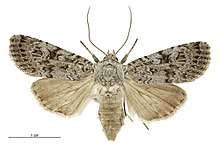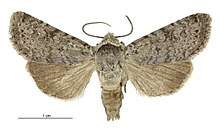Aletia inconstans
Aletia inconstans is a species of moth in the family Noctuidae. This species is endemic to New Zealand. It is found in both the North and South Islands but is considered a rare species.
| Aletia inconstans | |
|---|---|
 | |
| Female | |
 | |
| Male | |
| Scientific classification | |
| Kingdom: | |
| Phylum: | |
| Class: | |
| Order: | |
| Family: | |
| Subfamily: | |
| Genus: | |
| Species: | A. inconstans |
| Binomial name | |
| Aletia inconstans | |
| Synonyms[2] | |
| |
Taxonomy
This species was described by Arthur Gardiner Butler in 1880 using material collected by W. Skellon in Blenheim and named Spaelotis inconstans.[2][3] George Hudson discussed this species in his 1898 book New Zealand moths and butterflies (Macro-lepidoptera) as a synonym of Leucania griseipennis.[4] He again discussed as well as illustrated the species in his 1928 book The Butterflies and Moths of New Zealand under the name Aletia inconstans.[5] The holotype specimen is held at the Natural History Museum, London.[2]
The genus level classification of New Zealand endemic moths within the genus Aletia is regarded as unsatisfactory and is under revision.[6] It is likely that this species will be removed from the genus Aletia and be placed within one of the following genera: Physetica, Graphania, Tmetolophota or Ichneutica.[6] As such the species is currently also known as Aletia (s.l.) inconstans.[7]
Description
Butler described the species as follows:
Primaries above greenish-grey, indistinctly speckled with black; the ordinary lines ill-defined, formed by series of pale hastate or lunate markings edged internally with black, and connected here and there ; the innermost line replaced by three oblique independent zigzag lines, the outermost of which is interrupted by the "orbicular" spot, the latter being bounded internally by the central of the three lines ; the discoidal spots large, whitish, separated from one another and from the post-median line by black-edged dusky intervening spots; a marginal series of black dots; fringe sordid white, traversed by two slightly undulated greyish-brown lines; secondaries shining fuliginous brown with faint pinky reflections and diffused dusky border; fringe sordid white with very indistinct grey intersecting line; thorax grey, abdomen greyish-brown ; under surface greyish-white, speckled with grey scales towards the costal margins and apices of the wings; the latter are also sericeous with blackish discocellular >-shaped markings and indistinct traces of two nearly parallel greyish discal lines ; primaries with the discoidal area slightly dusky; tarsi brown. Expanse of wings 1 inch 5 lines.[3]
Distribution
This species is endemic to New Zealand.[1][8] Other than the type locality of Blenheim, this species has been found near the Buller River in the Westcoast,[9] at Quail Island and Hinewai Reserve in Canterbury,[10] and near Coronet Peak,[11] at Tara Hills Research Station,[12] and at Ida Valley in Otago.[5] This species has also been located in the North Island at Mount Taranaki,[13] Waiouru and Wellington.[5]
Biology and behaviour
This species is regarded as being rare.[5][13] It is on the wing from November to February.[5] This species is attracted to light and has been collected via light trapping.[12] It has also been collected through sugar trapping.[5]
Habitat and host species
A. inconstans prefers to inhabit open areas near forest or shrubland.[10]
References
| Wikimedia Commons has media related to Aletia inconstans. |
| Wikispecies has information related to Aletia inconstans |
- "Aletia inconstans (Butler, 1880)". www.nzor.org.nz. Landcare Research New Zealand Ltd. Retrieved 2018-06-12.
- Dugdale, J. S. (1988). "Lepidoptera - annotated catalogue, and keys to family-group taxa" (PDF). Fauna of New Zealand. 14: 200. ISSN 0111-5383. Retrieved 12 June 2018.
- Butler, A. G. (1880). "On a collection of Lepidoptera Heterocera from Marlborough Province, New Zealand". Cistula Entomologica. 2: 541–562 – via Biodiversity Heritage Library.
- Hudson, G. V. (1898). New Zealand moths and butterflies (Macro-lepidoptera). London. p. 9. doi:10.5962/bhl.title.7912. OCLC 727236768. Retrieved 12 June 2018.
- Hudson, G. V. (1928). The Butterflies and Moths of New Zealand. Wellington: Ferguson & Osborn Ltd. p. 57. OCLC 25449322.
- Hoare, R.J.B.; Rhode, B.E.; Emmerson, A.W. (March 2012). "Larger moths of New Zealand: Image gallery and online guide". Landcare Research. Landcare Research New Zealand Ltd. Retrieved 2017-12-18.
- "TNZOR Lepidoptera". Species-ID. Retrieved 2017-12-18.
- Gordon, Dennis P., ed. (2010). New Zealand inventory of biodiversity. Volume two. Kingdom animalia : chaetognatha, ecdysozoa, ichnofossils. Vol. 2. Christchurch, N.Z.: Canterbury University Press. p. 461. ISBN 9781877257933. OCLC 973607714.
- "Aletia inconstans (Butler, 1880) AI.030287". www.collections.tepapa.govt.nz. Retrieved 12 June 2018.
- Patrick, H.; Bowie, M.; Fox, B.; Patrick, B. (2011). "The moths of Quail Island (Ōtamahua): a faunal comparison of an island under restoration with other sites on Banks Peninsula". New Zealand Natural Sciences. 36: 57–72. hdl:10182/6365.
- Crown Pastoral Land Tenure Review Coronet Peak Conservation Resources Report - Part 2 (PDF) (Report). Land Information New Zealand. 2006. p. APPENDIX 6: Invertebrate Species List. Retrieved 12 June 2018.
- Patrick, B. H. (January 1989). "Survey of Lepidoptera at Tara Hills Research Station". New Zealand Entomologist. 12 (1): 42–48. doi:10.1080/00779962.1989.9722562. Retrieved 12 June 2018.
- Fox, K. J. (January 1970). "The Lepidoptera of the Egmont National Park" (PDF). New Zealand Entomologist. 4 (4): 30–38. doi:10.1080/00779962.1970.9723070. Archived from the original (PDF) on 2013-02-09. Retrieved 12 June 2018.